
18 minute read
The Creative Journey –The Art of Joyce Hyam
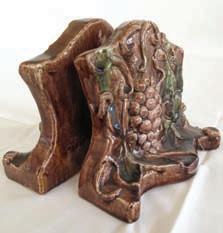
Essay written for Joyce’s Retrospective Exhibition at the Royal Queensland Arts Society, September – October 2004, by Greg de Silva.
Advertisement
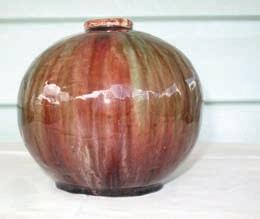
The Visual artist during a lifetime travels many roads, some are easy and some are difficult. Some are dotted with obstacles, while others are rough or steep. Some are plain sailing, with just that hint of excitement of what one may discover just around the next bend. This creative journey has taken Joyce Hyam down many visual roads from drawing & painting, prints, sculpture, interior decoration, batik and finally textiles. It is fitting that this Retrospective Exhibition of Joyce Hyam’s work held at the Royal Queensland Art Society from the 25th September ‘til the 24th October 2004,1 will bring together for the first time, over 45 years of visual delight in one space.
Never one to be tied down to one visual art form or technique,2 Joyce Hyam’s creative journey had humble beginnings. Born in Brisbane on the 18th January 1923, and eldest of four children to Ray and Gladys Anderson,3 her greatest inspiration during her childhood was the influence of her mother, Gladys Anderson (Keen).4 Of her mother, Joyce remembers: My Mother had been an artist when she was a girl. In those days in her family you either learnt music or painting. She did painting, and she was very good at it. She then went to England to study art just before the First World War. However, the war cut short this study and she returned to Australia 5 She then studied in Brisbane under Vida Lahey,6 who was well known for her exquisite flower paintings, executed in watercolour.7 She then started training as a nurse, married and began a family. That was really the finish of her art. However when Joyce was a teenager, Gladys did attend pottery classes with L.J Harvey and his school,8 sometimes joined by Joyce.9
Joyce was educated at Clayfield/Eagle Junction State School and later at Brisbane Girls Grammar School. At Brisbane Girls Grammar her favourite subject was, of course art, and she excelled in that subject. The art teacher there was Miss Cottew, who influenced a lot of the girls, including Joyce. This was really her first formal art training.10 After her schooling, she enrolled at the Stott’s Business College, followed by a stint at the National Bank typing for ten tellers (a job she hated). She then worked for a brief period at a photographic studio, during the war years, mostly photographing service men and women. Joyce often became bored and needed to stimulate her passion to learn and experience new things. This took her to Melbourne where she commenced working as a secretary for the Y.W.C.A.11 Joyce maintains: That’s where my education really started.12
Joyce returned to Brisbane after the war and acquired a position as an Activities Secretary for the Y.W .C.A (Brisbane). She underwent and completed a one-year training course for professional staff. She later relocated to Toowoomba for a short period, and was appointed to the Board of Directors at the Y.W.C.A, Brisbane for two years.13 It was shortly after this that she met and married Frank Hyam, and the couple pooled their 50 Pounds and purchased a block of land at 21 Elkhorn Street, Enoggera, in Brisbane.14 They built a house and have been there ever since. On the 1st of October 1952 their daughter Vivien was born.
Joyce began her serious art training (part-time) at the Central Technical College in George Street, Brisbane from 1959 until 1963, studying freehand drawing, colour study, general design, light and shade and painting.15 She studied with professional painters, Melville Haysom and Arthur Evan Read.16 Both artists had trained at the National Gallery School in Melbourne.17 Mel Haysom became senior instructor of painting and drawing at the Central Technical College. Arthur Evan Read went on to teach at the Royal Queensland Art Society, and in 1969 was appointed as a trustee at the Queensland Art Gallery.18
While Joyce was studying at the college, she was approached by Cyril Gibbs Chief Art Instructor) to conduct “Child Art” classes on a Saturday morning. These were a sheer joy, and Joyce adored them.19 She then took an Interior Decoration class, again at the suggestion of Cyril Gibbs. She later lectured to people taking Adult Education classes, which at the time were free. The pay was low, but the experience was great. Because there were no teaching books on interior decoration, Joyce wrote her own text book. The course was originally for a three year period, which she later designed and streamlined down to a one-year course.20
Joyce was keen to exhibit her work and liaise with other artists. She joined the Royal Queensland Art Society in the early 1960’s, and exhibited in their annual exhibitions and in the “Women’s Members” exhibitions. In the 5th annual RQAS Women’s Members exhibition in 1961 Cyril Gibbs noted: Joyce Hyam’s “Drift Wood is clean and crisp, with well handled opposing colour treatment.21 In the 1963 RQAS annual exhibition Joyce exhibited Towards Lands End and Industrial Derelicts. The latter work was commended by Dr. Gertrude Langer in the Courier-Mail. Joyce was now exhibiting with professional
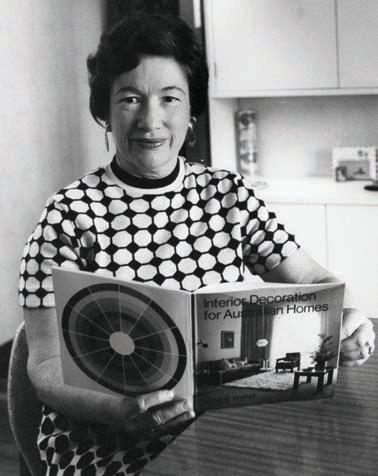
Queensland artists such as Herbert Carstens, David Fowler, Charles Ludlow, Peter Templeton, Dorothy McPhee and Caroline Barker.22
Contemporary art practices were being experienced in Brisbane in the late 1950’s and early 1960’s. This practice was instigated by private art teachers, such as Roy Churcher who was conducting private art classes at St Mary’s Studio at Kangaroo Point. He formed the Queensland branch of the Contemporary Art Society (C.A.S.) in September 1961. Churcher had trained in the Slade School in London, and brought with him new methods for teaching art.23 Joyce was a founding member of the C.A.S,24 and exhibited in their first exhibition at Hardy Brothers Gallery in March 1962. There were 47 exhibitors.25 Joyce exhibited Cracked Bowl in that exhibition, in company with John Aland, Milton Moon, Brian Hatch, Don Ross, Margaret Olley, Bronwyn Yeates and Roy Churcher.26 The Courier-Mail art critic, Dr. Gertrude Langer was overjoyed with the exhibition. She stated: The refreshing thing is that at last something is happening in this place, which for too long has been a backwater.27Joyce exhibited with the C.A.S. from 1963 to 1967, as well as the C.A.S Red Cross and Spring Warana exhibitions of 1967.28
Although Joyce did not study with Churcher, she did have the experience of teaching with him at the art school.29 During this time Joyce was teaching (part time) at the Central Technical College; the Kindergarten Teachers College at Kelvin Grove and the Board of Adult Education.30 She furthered her studies with private teachers including: Andrew Sibley, Bronwyn Yeates, John Aland and Jon Molvig. She says: Molvig was an excellent teacher. He always had a model, and I learnt a lot from him as far as drawing was concerned. She considered his classes a valuable experience.31 She also attended the Vacation Schools at the Queensland University. These were arranged by Dr. Gertrude Langer during the school vacation, and art students could experience the teaching practices of Stan Rapotec, Desiderius Orban, Lawrence Daws and Charles Reddington. Hyam claims: Those were the artists that helped me. It was from these schools that my awareness of abstraction began.32
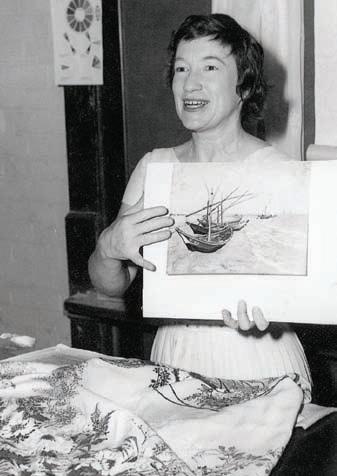
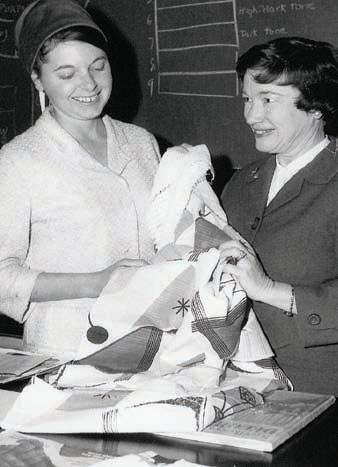
Joyce was also exhibiting in a variety of other venues, in order to get her work seen. She showed at Sylvia Monk’s gallery at Mermaid Beach, as well as the Quota Club in Brisbane, Hillsdon Kindergarten, the WaranaCaltex contest and the popular Redcliffe Art Contest. Her work was well received and she was hung along with her contemporaries: Rona van Erp, Mary Norrie, Ian Milton, Clarrie Ventnor, Joy Roggenkamp and William Robinson to name but a few.33 In the non-representational section of the 11th Annual Redcliffe Art Contest, her work Emergence caught the eye of the judge Sir William Dargie, which earned her a highly commended in the 1967 exhibition.34
The Wednesday Group was formed by a group of students, mostly from Roy Churcher’s classes, who were meeting at St Mary’s Studio at Kangaroo Point to paint. They had been using the studio since mid1961, and always meet on a Wednesday. All were members of the Contemporary Art Society, so the group was almost a sub-group of the parent body. The original members included Shirley Miller, Deidre Bennett, Beverley Budgen, Joy Hutton, Dorothy Akers, Rona Van Erp, Conty Robinson and Alison Coaldrake, who suggested the name. The group was officially named in August 1963. Irene Amos and Joyce Hyam joined that year, with Mona Gasteen joining in 1967.35 The group held the first of its five exhibitions in James Wieneke’s Moreton Gallery in July 1966.36The other four exhibitions were held at the Design Arts Centre in 1967, 1968, 1969 and 1972. Joyce exhibited in the 1966, 1969 and the 1972 shows. The group disbanded in the early 1970’s, with members going their own separate ways. Joy Hutton discovered printmaking, while Rona van Erp helped establish the Reid Gallery. Others were involved in the formation of the Institute of Modem Art in 1975,37 which continued on from the Contemporary Art Society, which closed in 1973. As Elizabeth O’Neal stated: They left behind through their surviving paintings a record of their artistic activity by which we can see that the criteria for change did not arise from a vacuum, but from a rich and varied tradition of painterly investigations by artists working in Queensland.38
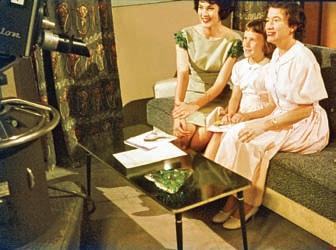
In 1968 Joyce, Frank and daughter Vivien spent a year in Germany. They lived in Munich, and Joyce had private lessons from the inspirational Waki Zollner. His studio was always beautifully decorated, with a fresh rose in a vase every day. This was very different from the facilities at the art school in Brisbane. It was there she learnt the technique of batik, and her first batik work was done in Munich. During this time Joyce illustrated a book, written by husband Frank. The Dreaming Time was published in Munich in 1969.39 Some of the batik works that Joyce created in Munich were entered in the H.C Richards Prize of 1969 at the Queensland Art Gallery. The Richards Prize was a good drawcard and it attracted many artists from down south to exhibit here. These included names like John Eldershaw, Tom Gleghorn, Carl Plate and David Rankin. It also included works by respected Queensland painters such as Sam Fullbrook, Frank de Silva, Nevil Matthews and George D. Williamson. Joyce also exhibited a batik artwork of her husband Frank, at the RAQS 11th Annual Women Members Exhibition that year.40
The 1970’s brought new changes to the arts. Joyce was still teaching at the College of Art, which had taken over from the old Central Technical College around 1971. Commenting on her teaching at the old tech, retiring Chief Instructor of Art, Cyril Gibbs said: Mrs Hyam has an enthusiastic and appealing approach to her work and has contributed much to the success of her students.41 Melbourne artist and critic, Alan Warren became the new Principal of the College of Art, which soon relocated to the suburb of Morningside. The college officially opened in 1974.42 Joyce left the college in 1983, notching up 21 years. However she was still teaching art and crafts for the School of Dental Therapy, a position she held until 1987.43 During this decade, she would become a published author and would hold her first solo showings of her work. Her years of teaching and lecturing on interior decoration would evolve into Interior Decoration for Australian Homes published by Jacaranda Press in 1972. The book was written because such a book was requested, and one had not been done before.44
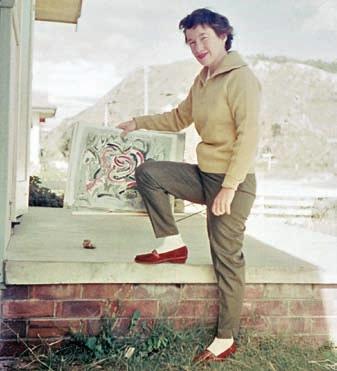
During the l974 Queensland Arts Festival, Joyce held the first solo exhibition of her work. The exhibition was held at the Abbott Gallery in Edward Street, from the 5th-12th May 1974, and was favourably reviewed. Dr Gertrude Langer said in the Courier Mail: Her watercolours based on flowers and organic growth, stress the fluidity of the medium and the best of them are the ones that are most free and sparse. However the most effective painting here shows a large petalled form, which radiates joy.45 The Sunday Mail critic Frederic Rodgers expressed: At one end of the variety are quasi-abstracts; at the other, a series of aesthetically conceived flower-based studies done in watercolour to which the artist has attached titles suggesting the evocation of names of female acquaintances. Rodgers continued: The exhibition reveals the artist as a competent operator with a distinct leaning towards romanticism.46
The following year she exhibited drawings at the Twelfth Night Theatre Club in Cintra Road, Bowen Hills. The exhibition was opened by Robert Cunningham, the Assistant Director of the Queensland Art Gallery.47 Speaking about her work Joyce says: My guiding principle is that through my hand and the tip of the pen flows something from the vast reservoir of accumulated knowledge - encompassing the principals of art, psychological awareness, and unconscious emotional sources. What I am “attending to” fluctuate at a rate faster than I could, or would control.48 Reviewed in the Courier Mail, Dr. Langer noted: Abstract and figurative elements intertwine fluidity in a rich play of line and colour - The works are crisp, joyous and full of charm 49 The Telegraph’s
Charmaine Cashel added: The exhibit is exciting while Frederic Rodgers from the Sunday Mail said: The work emerges as free, cheerful expressions of an idea that could be a constant stimulus to artistic thought in the mind of the viewers and the fortunate possessors. 50
Joyce never really gained in the ‘big’ Art Prize arena, but did have success winning prizes from time to time. The first significant one was for the “ Josephine Jenyns Prize” for best traditional painting at the 83rd RQAS Annual Exhibition in 1972. The contest was judged the selectors, Raoul Mellish, Alan Warren and Brian Dean, who awarded the prize to Joyce Hyam’s acrylic Autumn 51 Art historian Keith Bradbury pointed out: Although the painting was representational in form, it was contemporary in effect. So numerous were the negative comments about it, that Joyce resigned from the society,52 but not permanently. Joyce had further success in the Bribie Islands 4th ‘Arts Alive Festival’ in 1980. It was held in conjunction with Australian Theatre
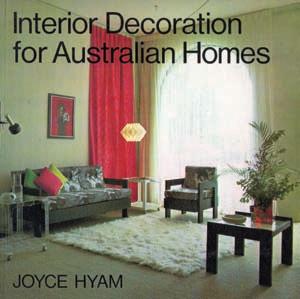
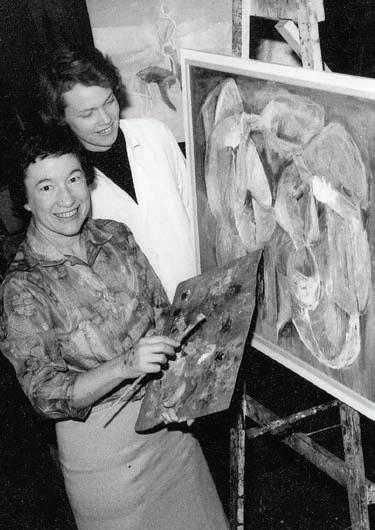
Week and Arts Festival. Joyce collected the first prize in the ‘Bribie Island Scene’ section. The judge Wilson Cooper deemed her painting Pending Storm the best.53 Her work from the early 1970’s to the early 1980’s was entered in exhibitions such as Quota Club Arts Festival; Aspley Art Contest; Dalby Art Contest; Redcliffe Art Contest; Westfield Art Prize (Toombul and Indooroopilly) and the Royal National Association (RNA) art contest. Her work was prized and commended by popular judges: Dr. Gertrude Langer, David Galloway, Peter Abraham, Harold Lane, Arthur Evan Read, and Don Hamilton.54

By the end of the decade she had another solo exhibition in Canberra, as well as exhibiting in “Survey 79” at the Verlie Just Town Gallery. Joyce was a new exhibitor with Verlie, along with Wilson Cooper, Veda Arrowsmith and Ruth Faeber. They joined the gallery’s fine stable of Australian artists, including John Coburn, Margo Lewers, David Schlunke, Judy Cassab, Graham Inson, and John Rigby.55 Joyce already knew Rigby – both were colleagues at the Queensland College of Art. The following year, Joyce had a solo exhibition at Verlie Just Town Gallery and commenting on the exhibition, and commenting in the exhibition catalogue Joyce stated: To interact with me, my art, your own self, experiences and mystique, then you need to disengage each time you go from one painting to the next. Should you discover a “dotted line” connecting them in some way, perhaps this line is your own personal contour 56 Frederic Rogers said of her works in the Sunday Mail: All are handled with a certainty that underlines the artist’s versatility. Her exhibit is, in effect, a vade mecum for students of art who, it is to be hoped, would make a close study. The Courier Mail’s Dr. Gertrude Langer summed up: When I first saw Joyce Hyam’s work many years ago, I thought she would develop best along the lines of decorative designing.57
From the early 1980’s Joyce was leaning towards textiles, because of the costs in framing.58 It was also another road that she would travel, and so find a new avenue for her creative talents. During the 1980’s and early 1990’s, Joyce exhibited textiles frequently with the “Half Dozen Group” of artists. In their 1993 exhibition she exhibited Wit Sun Days, a delightful work using satin stitch and machine appliqué techniques.59The work is an abstract impression using colour, pattern, line and plenty of imagination. This direction would be the future for Joyce Hyam. In talking about some of the techniques of textiles, Joyce explains: It is an interesting extension of the watercolour technique to paint on screens with fabric dyes instead of watercolours on paper. 60 Marbling crossstitch, machine quilting and even painting techniques on canvas were used by Joyce to create her textiles. Joyce continued her involvement in this field by attending workshops at the McGregor Summer and Winter Schools in Toowoomba. Her first rate tutors included Tori de Mestre, Pat Langford, Jan Irvine and Carol Wilkes. As a committed textile artist, Joyce discovers: As I experiment with new methods to achieve effects, sometimes the results are pleasing and exciting, which leads to future experiments and growth in techniques. 61
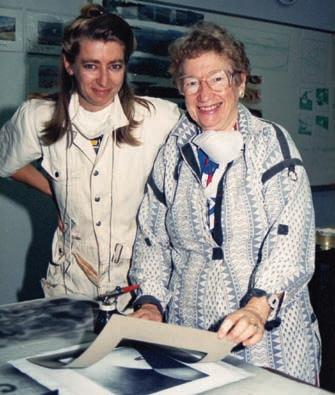
In 1993 she became a member of the “Textile Ten” group, with the aim of working together to promote textile arts through exhibitions. The group included: Pamela Hill, Tina Sutton, Judy-Anne Moule, Joan Apel, Rosemary Penfold and Pam Winsen. The group only ever had five members at one time. The thinking behind the name was ‘five women, ten hands, many pieces.’62 In the group’s 1994 exhibition at Narek Galleries, Canberra, Meredith Hinchliffe observed: Joyce Hyam is exhibiting three small pieces conveying the colours and movement of vibrant ocean life: “Deep Blue Sea 1, 2 and 3” “Pipe to the Spirit-After Dorrit Black” is quite different. Appliquéd figures in bright yellow move in a circle over a ground of purple/ mauve and pink/ blue. The quilting links the figures and forms shadow-like patterns.63 At the group’s showing at Verlie Just Town gallery in 1999, Joyce exhibited Seasons, which was later chosen by Bernina Australia for the ‘World Quilt Competition’ in North Carolina, USA in August 1999.64 Reviewing the exhibition in the Courier-Mail Jeff Shaw said: Hyam’s Seasons identifies leaf elements through a carefully considered exploration of colour and surfaces. This is by far her strongest and restrained work.65
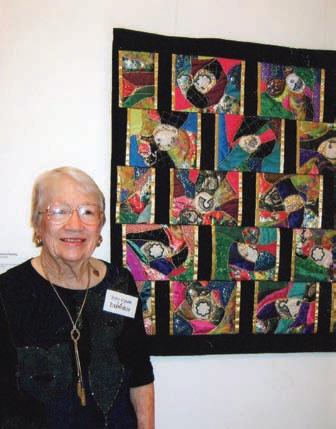
In 1996 Joyce created the outstanding “Alice” series, based on Lewis Carroll’s book and John Tenniel’s drawings. Joyce claims: I have used artistic licence in my interpretation. Of these works Kay Faulkner wrote: Lewis Carroll’s “Alices’ Adventures in Wonderland” come alive in a series of quilts by Joyce Hyam. Each a delightful interpretation of John Tenniel’s Illustrations, but only when viewed as a whole can they be fully appreciated.66 Frank Hyam added: Joyce has great joy in ‘fabricating’ those fabrications, in rendering them as material substance.67
Joyce has travelled many roads in her artistic life, knowing that she has created something beautiful for the enjoyment of others. This talent has netted her some outstanding accolades such as first prize in the 1998 Dame Mary Durack Outback Award at the Queensland Museum. She was also invited to exhibit in the “Australian Bounty” Travelling Exhibition throughout Australia and Europe in 2000. Her work Aura Australis was very Australian in concept.68

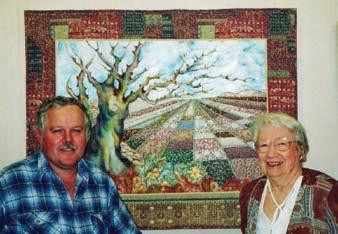
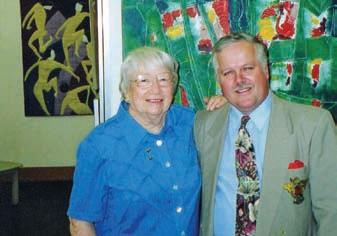
In recent years she had work judged in Lansing and Greensboro USA in 2002 and started exhibiting with a new group of textile artists. The new group “Textile Art Group” (TAG), got together at the Royal Queensland Art Society in 2003. The group consists of Liz Heber, Elaine
Morgan and Joyce Hyam.69 Speaking about her recent work Joyce says: Artistic interpretation reaches from drawing, design and colour, culminating in my present multi-media approach. I aim to produce work which sings and glows, by using a limitless range of fabrics and threads as well as paints.70 This creative journey has reached its pinnacle with this retrospective exhibition, which has given Joyce Hyam and the viewing public a lifetime of colour, imagination and sheer joy. In summing up on her diverse art form, Frank Hyam writes: To savour Joyce Hyam’s work, come to it open- mindedly, eager to hear colours sing, ingenuous laughter and sometimes, a sly undermining of the ground beneath the feet of the cognoscenti. The fountain of Youth is not somewhere else; it is within. All we need to do is keep it bubbling.71
© Greg de Silva: September 2004
1 “Joyce Hyam- Retrospective Exhibition RQAS” Textile Fibre Forum 75, 2004 p26
2 Joyce Hyam interview, Enogerra 2nd September 2004
3 Ibid; phone conversation Joyce Hyam, 3rd September 2004
4 Ibid
5 Joyce Hyam interview
6 Phone conversation with Joyce Hyam 3rd September 2004
7 See Battina Mac Auley: Songs of Colour. The Art of Vida Lahey. Queensland Art Gallery, 1989
8 Joyce Hyam interview; Joyce Hyam phone conversation
9 Phone conversation
10 Hyam interview
11 Ibid
12 Ibid
13 Ibid; YWCA Training Course Certificate 29th September 1947 in Joyce Hyam scrapbook
14 Hyam interview
15 Department of Education, Examination of Technical College Arts Certificates in Joyce Hyam scrapbook
16 Helen Fridemanis, Artists and Aspects of the Contemporary Arts Society, Queensland Branch. Boolarong Press, Brisbane1991, p.135
17 Steven Rainbird Melville Haysom, Ipswich City Council Art Gallery, 1987, p.7; Max Germaine, Artists and Galleries of Australia and New Zealand, Landsdowne Press 1979.p.471
18 Biographical notes on Melville Haysom in Half Dozen Group of Artists 22nd Annual Exhibition Catalogue,10-24 September 1962; Steven Rainbird, op cit; p.37;Germaine op cit; p471; Caroline Nolan, Ribbons Beads and Processions: the foundation of Stuartholme, Stuartholme School 1995 p 150;Leading Queensland Painter dies in Kent, Courier Mail 12 August 1978
19 Hyam interview
20 Ibid
21 C G Gibbs, Better Display of Art, Telegraph, Brisbane 9th November, 1961, p49
22 RQAS 75th Annual Exhibition Catalogue 8-20 July, 1963; Dr. Gertrude Langer, Arts Society Show Courier Mail, 19th July 1963
23 Elizabeth O’Neal. The Dynamics of the Wednesday Group. Glen R Cooke ed. Art off Centre Placing Queensland Art, Queensland Studies Centre, Griffith University , P.161; Helen Fridemanis, Contemporary Art Society Queensland Branch 1961-1973 (exhibition Catalogue) Brisbane City Hall Art Gallery Museum 1991
24 Hyam interview
25 Glenn R Cooke, A Time Remembered. Art in Brisbane. 1950-1975
26 Contemporary Art Society (C.A.S) 1(Exhibition Catalogue) Autumn 1962
27 Dr. Gertrude Langer. Contemporary Art Body Puts on First Show. Courier Mail, 4th April 1962. P.2
28 Information of C.A.S. Exhibitions in Joyce Hyam scrapbook
29 Hyam interview
30 Joyce Hyam CV 2002
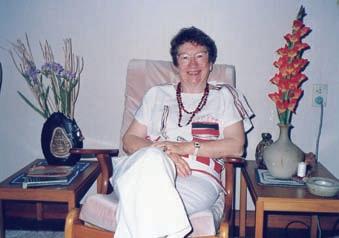
31 Fridemanis op cit p.135; Hyam interview
32 Hyam Curriculum Vitae; Hyam interview; O’Neal op cit p.161. August School of Creative Arts Program 1964
33 Quota Club Brisbane 1964; Warana-Caltex 1964 Redcliffe Art Contest 1963-64 (Exhibition catalogues)
34 Redcliffe Art Contest 11th Annual Exhibition (Exhibition Catalogue)
2-16 September 1967
35 Glenn R Cooke, Women of the Vital Decade. A Contemporary Cast. A Homage to Women Artists in Queensland Past and Present. Centre Gallery, Surfers Paradise. 1988 p.17
36 Ibid
37 O’Neal op cit. p.166
38 Ibid
39 Hyam interview; Betty Patterson Now She Paints in Batik. Sunday Mail, 19th January 1969
40 H C Richards Memorial Prize for Painting 1969 (Exhibition catalogue) Queensland Art Gallery 1969; RQAS Women’s 11th Annual Exhibition, RQAS, 1969
41 Reference by Cyril Gibbs, 30th November 1971 in Joyce Hyam scrapbook
42 Glenn R Cooke. John Rigby, A Career Revealed. The World of Antiques and Art, 66th ed. Feb-Aug 2004 p.105
43 Hyam Curriculum Vitae
44 Ibid: Her Book Turns a House into a Home. Undated press cutting, 1972. Joyce Hyam scrapbook
45 “Crusades” Near End, Courier Mail 29th April 1974: Dr. Gertrude Langer Courier Mail 11th May 1974 p.2
46 Fredric Rogers, Mood and Style. Sunday Mail 12th May 1974
47 Invitation and Exhibition Catalogue, Joyce Hyam Drawings. Twelfth Night Theatre Club. 14th July- 2nd August 1975
55 Joyce Hyam CV Survey 79, Verlie Just Town Gallery 1979
56 Joyce Hyam quoted in Joyce Hyam (Exhibition Catalogue) Verlie Just Gallery Gallery, 1980
57 Fredric Rogers, ‘Together Two Artists Strike Happy Medium’ Sunday Mail 3rd August 1980; Dr. Gertrude Langer ‘Iridescent Veils and Images’ Courier Mail 30th July 1980
58 Joyce Hyam interview
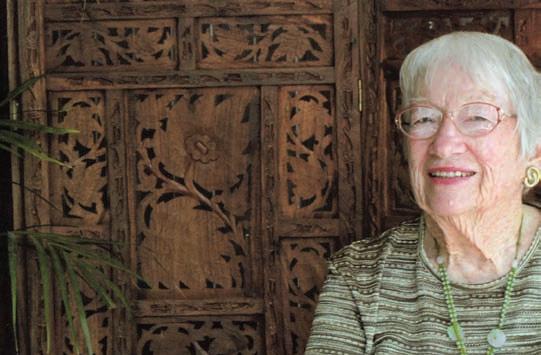
59 Information in Joyce Hyam scrapbook; Half Dozen Group of Artists City Exhibition (Exhibition Catalogue) 19th -30th April 1993; information in Joyce Hyam file
60 Joyce Hyam, Why Textiles? Textile Fibre Forum, no. 24, 1989, p.31
61 Hyam CV: artist’s statement in Hyam file
62 Down Under Quilts June-July 1998 p.12; Hyam file
63 Meredith Hinchcliffe, ‘Pursuit of Excellence in Textiles’ The Canberra Times, 17th July 1994 p.18
64 Textile Fibre Forum no. 56 1999 p.52
65 Jeff Shaw, ‘Textile Ten Stitch up a Rich Fabric of Expression’ Courier Mail 28th April 1999 p.39
66 The Alice Series – Joyce Hyam, Textile fibre Forum, no.53, 1998 p.40; Kay Faulkner ‘Contemporary Fibre Art, Ontario Hand Weavers and Spinners c. 1998 USA
67 Frank Hyam ‘Inspiration in Colour and Stitch’ The World of Embroidery. Vol 48, no.2, March 1997 UK p. 150
68 Hyam CV; Australian Bounty Quilts Australiennes-Natura 2000 (exhibition catalogue)
69 Hyam CV; Focus on Fabric, exhibition invitation RAQS 2003
70 Joyce Hyam quoted in ibid
71 Frank Hyam, Artful Humour. Undated article in Joyce Hyam scrapbook
Joyce, age 87, 2010, Brisbane.
48 Joyce Hyam quoted in ibid
49 Dr. Gertrude Langer. ‘Fluid Line Play’ Courier Mail 19th July 1975 p.2
50 Charmaine Cashel, Telegraph 16th July 1975; Fredric Rogers, ‘With a Little Help from IMA’, Sunday Mail, 27th July 1975
51 Invitation on this prize on back of invitation to 83rd Annual RAQS Exhibition, RAQS (Exhibition Catalogue) 18- 30 July 1972
52 Keith Badbury & Glen R Cooke. Thorns and Petals 100 Years of Royal Queensland Art Society. RAQS 1988 p.188
53 Win Davson (ed) Australian Theatre Week and Arts Festival Quarterly Bulletin, April 1980 p.12
54 Information in Joyce Hyam scrapbook




